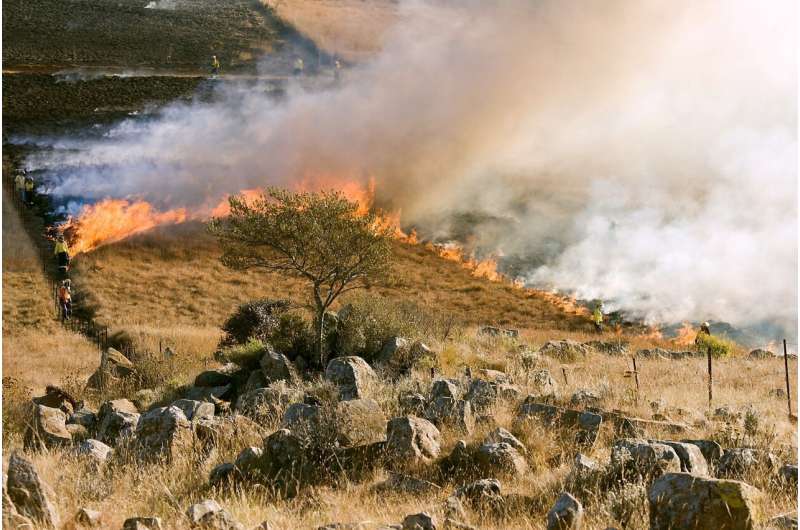This article has been reviewed according to Science X's editorial process and policies. Editors have highlighted the following attributes while ensuring the content's credibility:
fact-checked
peer-reviewed publication
trusted source
proofread
Controlled burns help prevent wildfires, but climate change is limiting their use

Prescribed fires, sometimes called controlled burns, are one of the most common tools for preventing catastrophic wildfires in the Western United States. Lit by highly trained firefighters, they help clear away excess dry plant matter that might otherwise turn a healthy vegetation fire into a raging inferno.
To safely carry out controlled burns, firefighters must wait for specific weather conditions: not so damp as to prevent combustion, but not so dry or windy as to burn more vegetation than intended. These conditions limit the opportunities.
Now, a new study led by UCLA climate scientist Daniel Swain has found that that climate change is further reducing the overall number of days and changing the times of year when prescribed fires can be safely used.
Currently, scientists project warming of 2.0° Celsius (3.6° Fahrenheit) by 2060—a projection Swain called "optimistic" given the current trajectory of even greater warming. Still, these temperatures would reduce the number of days when weather and vegetation conditions favor prescribed fires by 17% on average across the Western U.S.
Most reductions would come in spring and summer, when most prescribed burns are currently implemented. Yet in winter, the research projects a net 4% increase in the number of favorable days for prescribed fire.
Paper co-author Kristen Shive, a UC Berkeley expert on forests, wildfires and prescribed fire, said specific burn prescriptions vary by location and vegetation type, but target temperatures commonly range from 50–70° Fahrenheit with 10–20% relative humidity.
Climate change will require the agencies responsible for prescribed burns to adjust, Swain said, because most personnel who prepare for and manage prescribed fires are seasonal workers whose jobs end by mid-autumn each year. Going forward, the use of prescribed fires will require changes in staff availability.
"Global warming will reduce the number of favorable days for prescribed fires throughout the American West, but winter in particular may emerge as an increasingly favorable time for prescribed burns if the relevant policy and staffing changes can be made," Swain said.
The researchers also found regional variation in the changes. In California, for example, the changes are most pronounced in coastal and southern parts of the state, with many places losing a month of days suitable for prescribed fires each year. The northern parts of the Rocky Mountains, on the other hand, may see a modest increase in days when it's safe to use these fires.
Yet not much will change in the short term, according to Swain.
"We're just not doing a lot of prescribed fire compared to what is needed, at scale, to really address the escalating wildfire crisis," he said.
The study, published in Communications Earth and Environment, included research from UCLA, UC Berkeley, UC Merced and the Nature Conservancy. It focused on historical and projected climate conditions and vegetation dryness, comparing 1980–2020 with 2020–2060. The researchers did not address other factors important to the use of prescribed fire: impact on ecology, public policy considerations, effects of smoke on humans and wildlife, and availability of staff to do prescribed burns.
As wildfires in the American West have dramatically increased for a variety of reasons—including climate change, human development in fire-prone areas and aggressive fire suppression in the 20th century—tools like prescribed fires will only become more critical. Anticipating future opportunities and limitations to the use of this tool enables agencies to plan ahead, particularly as regards the firefighting work force.
"This paper is giving us advanced warning," Shive said. "Hopefully we can change policies to either extend those folks or create winter-specific crews."
More information: Daniel L. Swain et al, Climate change is narrowing and shifting prescribed fire windows in western United States, Communications Earth & Environment (2023). DOI: 10.1038/s43247-023-00993-1
Journal information: Communications Earth & Environment
Provided by University of California, Los Angeles





















